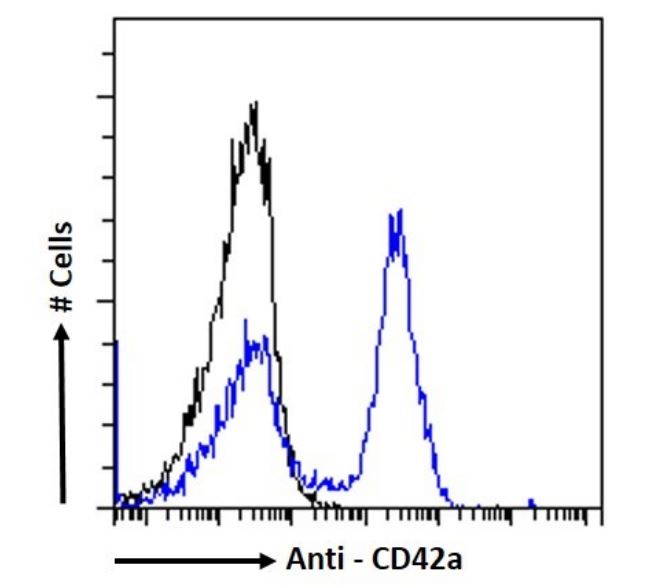How it Started

Figure 1. A: MFI of normal human platelets stained with anti-CD42a-FITC conjugates. B: Medium FITC:Ab Ratio unstained and at 300 ng concentration.
Absolute Antibody has sequenced and saved a number of invaluable antibodies over the years, including one with a therapeutic potential for malaria. It is because of this experience that our sister company, Exalpha, came to us with their dilemma. They had a popular mouse anti-human CD42a clone ESS antibody that, unfortunately, fell victim to circumstances that are not uncommon for antibodies. The monoclonal antibody stock became depleted and the hybridoma could not be used for production or sequencing. Instead of surrendering to fate, Exalpha partnered with us to sequence the antibody protein and produce it recombinantly.
Platelet Glycoprotein and Antibody Interactions
CD42a, or Platelet glycoprotein IX (GP9), is a small, single-chain membrane glycoprotein of 22 kDa found on the surface of human platelets. It forms a noncovalent complex with CD42b, CD42c and CD42d (GPIbα, GPIbβ, and GPV). The GPIb-IX-V complex is the platelet receptor for von Willebrand factor and is known as von Willebrand’s factor-dependent adhesion receptor. The CD42a expression is restricted to platelets and megakaryocytes and, as a result, the mouse anti-human CD42a antibody reacts with resting and activated platelets, and weakly on monocytes and megakaryocytes.
Protein Sequencing and Recombinant Expression
Exalpha had only a small amount of the antibody left, specifically 50 ug of FITC-conjugated CD42a antibody formulated with gelatin as a carrier protein. Before the antibody protein could be sequenced, it needed to be separated from the gelatin. Absolute Antibody scientists were able to perform small-scale immunoprecipitation to achieve this. With sufficient purity obtained, the next step was to de novo sequence the fluorescein-conjugated antibody.
De novo sequencing technology is used to sequence both monoclonal and polyclonal antibody proteins and delivers complete antibody sequences, including CDRs. The process starts with purified antibody which undergoes multi-enzyme digestions. Next, the fragments are measured with LC-MS/MS to derive the de novo peptide sequences. These fragments are then analyzed to assemble full-length antibody sequences. Using this method, we sequenced the anti-CD42a antibody and then reviewed the full-length sequence for accuracy. It was then time to recombinantly express the protein using Absolute Antibody’s proprietary HEK cloning platform.
Absolute Antibody utilizes HEK and CHO platforms to swiftly generate animal-free recombinant antibodies at milligram-to-gram scale. Employing a serum-free mammalian transient expression system, we provide a more rapid and cost-effective option compared to stable cell line generation. Our system has proven to be successful in producing recombinant antibodies of any species, isotype, or format with exceptional purity and minimal endotoxin levels. The anti-CD42a sequence was recombinantly expressed in HEK293 cells and purified by Protein A purification. The final product had a purity >98% by SEC-HPLC and <0.5 EU/mg endotoxin as determined by LAL-test.

Figure 2. Flow cytometry using anti-CD42a antibody ESS. Human peripheral blood leucocytes were stained with the anti-unknown specificity antibody (black line) or the mouse IgG1 version of ESS (blue line).
Successful sequencing and expression of the CD42a antibody, while important, is not the end of the process. Knowing the functionality of the antibody is crucial to utilizing it for research purposes. To help determine the antibody’s capabilities, Absolute Antibody tested various conjugate concentrations to demonstrate optimal levels for flow cytometry assays. The recombinant CD42a antibody was conjugated at three different FITC:Ab ratios, and the resulting conjugates were tested in eight different concentrations in a flow cytometry assay on appropriate target cells (Figure 1). The results allowed us to determine antibody concentrations giving maximal fluorescence signal without over-saturating the assays.
What Came Next
Antibody sequencing and recombinant expression can help save an antibody from catastrophic loss, and engineering can provide tailor-made antibody solutions. Using our recombinant antibody engineering expertise, Absolute Antibody produced three further formats of the anti-CD42a antibody in addition to the original mouse IgG1: rabbit IgG, human IgG1, and Fc Silent™ human IgG1. All versions of the antibody are available on our website and can be further customized to meet your specific needs. Flow cytometry analysis of human peripheral blood leucocytes using the mouse IgG1 antibody can be seen in Figure 2.
Whether you have access to a hybridoma, or only the antibody protein, our team of recombinant experts will work with you to ensure the best possible outcome for your antibody. If you are interested in customizing your antibody, our scientists can advise which formats will work best for your requirements. Learn more about our industry-leading recombinant services and contact us to get started on your next project.
Latest News
Upcoming Events
Please join us at the following conferences and events. Stop by our booth, or get in touch to arrange a meeting.
See All Dates
 United Kingdom (UK)
United Kingdom (UK)